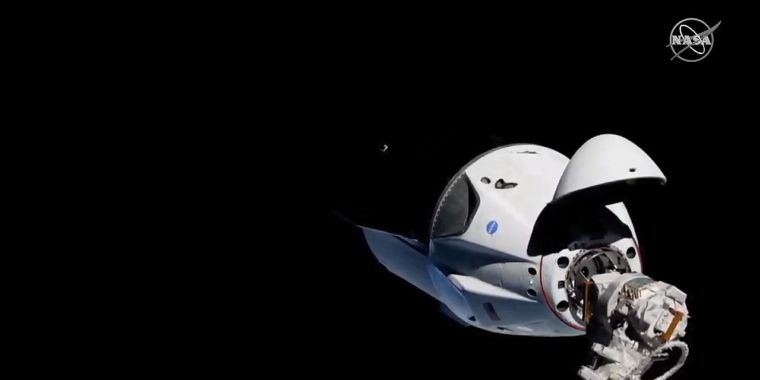
Right on schedule, the Crew Dragon spacecraft fired its Draco thrusters early on Sunday morning and docked safely with the International Space Station. A “soft” capture came at 5:51am ET, when the station was 418km above New Zealand. “Hard” capture, when 12 additional latches secured the spacecraft to the station, occurred 10 minutes later.
This marked the completion of a major milestone for SpaceX and NASA—the autonomous docking of a Dragon spacecraft with neither the assistance of crew on board the station nor the robotic arm used to grab and guide the cargo version of the Dragon spacecraft during supply missions.
Speaking on the space agency’s webcast shortly after the capture, NASA astronaut Bob Behnken noted the smoothness of the operation. “It’s one more milestone that gets us ready for flight,” he said. Behnken, along with fellow astronaut Doug Hurley, will fly the first crewed mission of the Dragon spacecraft later this year (or early in 2020).
NASA last used this docking port on the space station during the final space shuttle mission when Atlantis visited, way back in August 2011. Shuttle docking operations were labor intensive, requiring a lot of manual flying, and up to four crew members on board the orbiter had to actively monitor systems during the approach. With the crew-rated Dragon capsule—at least when everything goes right, like it did today—the astronauts on board will be observers as the spacecraft docks autonomously.
Very different
Because of this requirement to steer itself toward the station, Saturday morning’s docking procedures were closely watched. “This is very different from berthing a Cargo Dragon,” said former NASA astronaut Garrett Reisman, who played a senior role in the development of the Crew Dragon spacecraft at SpaceX from 2011 to 2018.
Docking required a number of things to go right—Dragon had to find the proper corridor to approach the station, then attain a proper relative velocity, and then its navigation sensors had to work. A new docking adapter installed in 2016 on the station for Dragon and Boeing’s Starliner capsule that had yet to be tested by a visiting spacecraft also went through its first operational use.
The Russians were concerned enough about Dragon’s approach that they didn’t sign off until late last week, and the Roscosmos cosmonaut on the station, Oleg Kononenko, was instructed to remain in the station’s Russian segment during the docking procedure in case of an emergency. Had the Dragon crashed into the space station, all three crew members on board—Kononenko, NASA’s Anne McClain, and Canadian David Saint-Jacques—would have moved into one of the Soyuz capsules attached to the station for safety.
This proved thankfully unnecessary. In fact, shortly after the docking Roscosmos congratulated NASA with a nice GIF of the maneuver.
After leak checks, the crew on board the station proceeded to inspect the docking adapter between the station and spacecraft. The crew then donned protective air masks as a precaution before opening the hatch, to ensure there were no particulates in the air that may have escaped during launch or spaceflight.
Finally, at 8:07am ET, as the space station flew over the Atlantic Ocean, Saint-Jacques opened the hatch and entered Dragon. Inside, he and Kononenko took atmospheric readings to ensure its safety before circulating air between Dragon and the station. Soon, they had begun transferring cargo from the spacecraft into the station.
The Dragon will now remain attached to the space station until early Friday morning, at which time it will undock, fly away from the station, and return to Earth.
